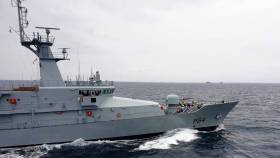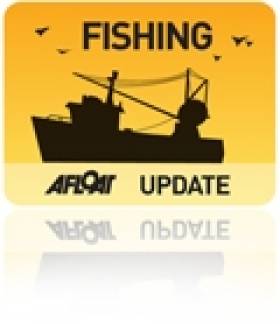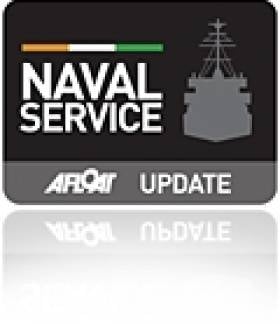Displaying items by tag: Detention
Detention of Fishing Vessel off Dublin Coast for Alleged Breach of Fishing Regulations
The Irish Defence Forces, reports Journal.ie, have detained a fishing vessel off the coast of Dublin (yesterday) for allegedly breaching fishing regulations.
The vessel was stopped 20 nautical miles northeast of Howth in Co Dublin by the Naval Service Vessel LÉ George Bernard Shaw.
The boat was brought back to Howth where it was handed over to An Garda Síochána.
This is the seventh vessel detained by the Naval Service so far in 2019, according to Defence Forces spokesperson.
“The Defence Forces conducts at sea fishery inspections in line with the service level agreement with the Sea Fishery Protection Authority, as part of its delivery of government services to the state,” they added.
Detention of Cruiseship Chiefly Concerned Condition of Lifeboats
#Detention - Among the reasons cited for the detention of a cruiseship in Dublin Port which has remained docked for almost three weeks, Afloat can now reveal chiefly concerned the condition of the ship's lifeboats, writes Jehan Ashmore.
According to the ship's agent, repairs have been made to the slewing mechanism of the lifeboats of the Maltese flagged motoryacht M.Y. Variety Voyager which was detained on August 1st. Also arising were issues over crew safety training.
The 72 passenger megayacht operated by Greek based Variety Cruises, had arrived in the capital on June 27 following a call in the UK.
The detention of the 2012 built ship was imposed by the Paris MoU, the authority responsible for eliminating the operation of sub-standard ships. This led to the cancellation of the cruise resulting in passengers forced to vacate the 68m vessel and be flown out of the country.
Last week a reinspection took place of Variety Voyager and today is been repeated by the maritime authorities. This is to ensure various regulatory bodies among them the International “Safety of Life At Sea” (SOLAS 2010) regulations are met on board the cruiseship.
The reinspection will determine weather or not the detained cruiseship with a crew of up to 33 is to be granted permission to finally depart the port later today.
In addition since the detention took place, it is understood Variety Voyager has shifted berths twice to free up berths for other visiting cruisecallers. The ship's current location is at Sir John Rogersons Quay in the capital's old docklands which is situated much closer to the city centre.
Cruiseship Under 'Detention' Remains Docked in Dublin Having Arrived Almost Three Weeks Ago
#Detention - A Maltese-flagged cruiseship still remains under detention in Dublin Port having arrived in the capital almost three weeks ago, writes Jehan Ashmore.
Authorities, Paris MoU, the official body responsible for eliminating the operation of sub-standard ships (see list) detained the diminutive luxury megayacht cruiseship Variety Voyager on 1 August.
Five days previously, Variety Voyager at just 1,593 gross tonnes had according to Dublin Port website docked on 27 July. This is only the second season that operator, Variety Cruises has deployed the 2012 built ship in Irish waters. The 72 guest /36 cabin vessel is among an eclectic fleet of 8 cruiseships including sail-assisted vessels.
The Paris MoU (Memorandum of Understanding) consists of the 27 participating Maritime Authorities that agree to implement a harmonized system of Port State Control. The detention of Variety Voyages was imposed through a harmonized system of port State control. Ireland is a member of the Paris MoU along with countries throughout Europe, Canada and Russia.
Originally Variety Voyager had arrived at Ocean Pier's Berth 35. The detention however led to the ship shifting berths upriver to Sir John Rogersons Quay Berth No. 8 which is designated a cruise-berth which is sited closer to the capital's city centre.
As a reference point to Berth 8's location, the restored 'Diving Bell' painted in bright orange is located close to Variety Voyager.
Coincidentally the last detained cruiseship in Dublin Port, Berlin also Maltese flagged, was berthed yesterday in the capital too.
Berlin just shy of 10,000 gross tonnes is operated by FTI Cruises. The 400 passenger capacity cruiseship was detained for three days in June. On this occasion, the 1980 built ship, yesterday occupied North Wall Extentsion, the next nearest cruise berth to Sir John Rogersons Quay.
Afloat will be monitoring as to when the cruiseship will finally make a departure.
Fishing Vessel Detained in Cork
The Irish Times reports that the Naval Service detained a Spanish-registered fishing vessel off the Clare coast in the early hours of Tuesday morning.
The vessel was escorted by the LE Niamh to Castletownbere in Co Cork, where it was handed over to gardaí in relation to an alleged breaching of fishing regulations.
No other information is yet known but Afloat.ie will update as details arise.
UK Registered Trawler Detained off Bray Head
of the Gardai. The L.E. Orla which berthed alongside the harbour's Carlisle Pier, is designated as a coastal patrol vessel (CPV) along with sistership L.E. Ciara (P42).
This is the second detention of a vessel this year. According to the Naval Service in 2010 there were 1666 boardings carried out which resulted in warnings to 70 vessels and eight detentions.































































